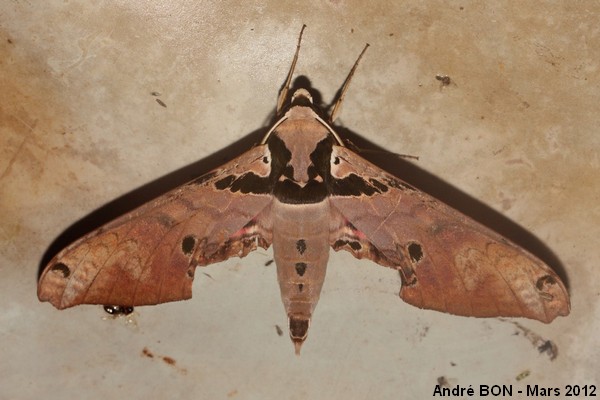
| Adhemarius gannascus (Stoll, 1790) |

|
|
Scientific name: Adhemarius gannascus (Stoll, 1790) Common name: French name: Order: Lepidoptera Suborder: Heterocera Family: Sphingidae Subfamily: Smerinthinae Wingspan: 90mm-110mm for males and 100mm-125mm for females. Biotope: Geographic area: From Mexico to northern Argentina. Flight time: All year round. Number of generations : Caterpillar: Caterpillars can show a ground colour varying from yellow to bright green or pale green. The upper side is marked with thin yellow longitudinal lines touching an alignment of black dots. The top of the head may be raised in some kind of a cone tip shape. The body ends with the typical tail of the Sphingidae family. Host plant: Lauraceae (Rubiacaeae) and Ocotea veraguensis, Persea povedae, Persea americana and Nectandra salicina. |
The upper side of the thorax of Adhemarius gannascus is greyish with a broad black band on each side joined by a transverse band next to the abdomen. All these bands draw some kind of a U-shape. The upper side of the abdomen is greyish with a black tip and two black spots on the middle segments. The upper side of the fore wings is greyish to brownish with a broad black continuous band crossing the basal area from edge to edge. There is a rounded black post medial spot close to the inner edge and a small narrow elongated crescent-shaped spot at the apex close to the costal edge. The other species of the Adhemarius genus show larger and often more rounded spots at the apex of the fore wings. The hind wings are pink and fading to greyish towards the inner edge. They are crossed by a black median band, a black post medial band and a black submarginal band. The last two bands, with serrated edges, draw rows of small pink spots. The underside of the body and of the wings is pinkish. |
| [To know more about the Adhemarius gannascus] [Top] |

|
I have shot this picture at Roura, at Camps Patawa, during a light trap night session. I have mainly based the species identification on the size and shape of the spots at the apex of the fore wings. I had a doubt because the band crossing the basal area appears discontinuous. However you can notice that there is some black colour up to the costal edge. |